An Agent-Based Modeling Framework for Simulating Human Exposure to Environmental Stresses in Urban Areas
Abstract
:1. Introduction
1.1. Human Exposure to Environmental Stresses
1.2. Human Health in Urban Environments
1.3. Dynamics of Environment Exposure
2. Modeling Approaches for Assessing Environment Exposures
2.1. Modeling of Exposure Sources
2.2. Modeling of Population Exposure
2.3. Modeling of an Individual’s Exposure Degree
2.4. Research Gaps and Capacities of Agent-Based Modeling
3. An Agent-Based Modeling Framework
3.1. Model Structure
3.2. Modeling Environment
3.3. Agent Attributes and Behaviors
3.4. Daily Routines of Agents
3.5. Model Formulation
3.6. Exposure Assessment
4. A Prototype Application of the ABM Framework to the Case of Hamburg
4.1. Data Preparation
4.2. Settings of Agents
4.3. Performed Simulations
4.4. Preliminary Results
5. Conclusions and Outlooks
Acknowledgments
Author Contributions
Conflicts of Interest
References
- IPCC. Managing the Risks of Extreme Events and Disasters to Advance Climate Change Adaptation. A Special Report of Working Groups I and II of the Intergovernmental Panel on Climate Change; IPCC: Cambridge, UK; New York, NY, USA, 2012; p. 582. [Google Scholar]
- Yang, L.; Scheffran, J.; Qin, H.; You, Q. Climate-related flood risks and urban responses in the pearl river delta, china. Reg. Environ. Chang. 2015, 15, 379–391. [Google Scholar] [CrossRef]
- Kovats, R.S.; Hajat, S. Heat stress and public health: A critical review. Ann. Rev. Public Health 2008, 29, 41–55. [Google Scholar] [CrossRef] [PubMed]
- Lankao, P.R.; Qin, H. Conceptualizing urban vulnerability to global climate and environmental change. Curr. Opin. Environ. Sustain. 2011, 3, 142–149. [Google Scholar] [CrossRef]
- Clausen, G.; Wyon, D.P. The combined effects of many different indoor environmental factors on acceptability and office work performance. Hvac&R Res. 2008, 14, 103–113. [Google Scholar]
- Bai, X.M.; Nath, I.; Capon, A.; Hasan, N.; Jaron, D. Health and wellbeing in the changing urban environment: Complex challenges, scientific responses, and the way forward. Curr. Opin. Environ. Sustain. 2012, 4, 465–472. [Google Scholar] [CrossRef]
- Dias, D.; Tchepel, O. Modelling of human exposure to air pollution in the urban environment: A gps-based approach. Environ. Sci. Pollut. Res. 2014, 21, 3558–3571. [Google Scholar] [CrossRef] [PubMed]
- Evance, G. Environmental Stress; Cambridge University Press: Cambridge, UK, 1983. [Google Scholar]
- Von Szombathely, M.; Albrecht, M.; Antanaskovic, D.; Augustin, J.; Augustin, M.; Bechtel, B.; Bürk, T.; Fischereit, J.; Grawe, D.; Hoffmann, P. Conceptional modeling approach to health related urban well-being. Urban Sci. 2017, 1, 17. [Google Scholar] [CrossRef]
- Schnell, I.; Potchter, O.; Yaakov, Y.; Epstein, Y.; Brener, S.; Hermesh, H. Urban daily life routines and human exposure to environmental discomfort. Environ. Monit. Assess. 2012, 184, 4575–4590. [Google Scholar] [CrossRef] [PubMed]
- Rosenzweig, C.; Solecki, W.D.; Hammer, S.A.; Mehrotra, S. Climate Change and Cities: First Assessment Report of the Urban Climate Change Research Network; Cambridge University Press: Cambridge, UK, 2011. [Google Scholar]
- Kjellstrom, T.; Friel, S.; Dixon, J.; Corvalan, C.; Rehfuess, E.; Campbell-Lendrum, D.; Gore, F.; Bartram, J. Urban environmental health hazards and health equity. J. Urban Health Bull. N. Y. Acad. Med. 2007, 84, 86–97. [Google Scholar] [CrossRef] [PubMed]
- Silva, R.A.; West, J.J.; Zhang, Y.Q.; Anenberg, S.C.; Lamarque, J.F.; Shindell, D.T.; Collins, W.J.; Dalsoren, S.; Faluvegi, G.; Folberth, G. Global premature mortality due to anthropogenic outdoor air pollution and the contribution of past climate change. Environ. Res. Lett. 2013, 8, 034005. [Google Scholar] [CrossRef]
- U Nations. World Urbanization Prospects—The 2014 Revision; Department of Economic and Social Affairs: New York, NY, USA, 2014. [Google Scholar]
- Chan, M.; Solheim, E.; Taalas, P. Working as one un to address the root environmental causes of ill health. Bull. World Health Org. 2017, 95, 2. [Google Scholar] [CrossRef] [PubMed]
- Steinle, S.; Reis, S.; Sabel, C.E. Quantifying human exposure to air pollution-moving from static monitoring to spatio-temporally resolved personal exposure assessment. Sci. Total Environ. 2013, 443, 184–193. [Google Scholar] [CrossRef] [PubMed] [Green Version]
- McGeehin, M.A.; Mirabelli, M. The potential impacts of climate variability and change on temperature-related morbidity and mortality in the united states. Environ. Health Perspect. 2001, 109, 185–189. [Google Scholar] [CrossRef] [PubMed]
- Watson, A.; Bates, R.; Kennedy, D. Assessment of human exposure to air pollution: Methods, measurements, and models. In Air Pollution, the Automobile, and Public Health; National Academies Press: Washington, DC, USA, 1988. [Google Scholar]
- Yang, L.E.; Hoffmann, P.; Scheffran, J. Health impacts of smog pollution: The human dimensions of exposure. Lancet Planet. Health 2017, 1, 132–133. [Google Scholar] [CrossRef]
- Willers, S.M.; Jonker, M.F.; Klok, L.; Keuken, M.P.; Odink, J.; van den Elshout, S.; Sabel, C.E.; Mackenbach, J.P.; Burdorf, A. High resolution exposure modelling of heat and air pollution and the impact on mortality. Environ. Int. 2016, 89, 102–109. [Google Scholar] [CrossRef] [PubMed]
- Dhondt, S.; Beckx, C.; Degraeuwe, B.; Lefebvre, W.; Kochan, B.; Bellemans, T.; Panis, L.I.; Macharis, C.; Putman, K. Health impact assessment of air pollution using a dynamic exposure profile: Implications for exposure and health impact estimates. Environ. Impact Assess. Rev. 2012, 36, 42–51. [Google Scholar] [CrossRef]
- Fryer, M.; Collins, C.D.; Ferrier, H.; Colvile, R.N.; Nieuwenhuijsen, M.J. Human exposure modelling for chemical risk assessment: A review of current approaches and research and policy implications. Environ. Sci. Policy 2006, 9, 261–274. [Google Scholar] [CrossRef]
- Gottschalk, F.; Scholz, R.W.; Nowack, B. Probabilistic material flow modeling for assessing the environmental exposure to compounds: Methodology and an application to engineered nano-tio2 particles. Environ. Model. Softw. 2010, 25, 320–332. [Google Scholar] [CrossRef]
- Schnell, I.; Potchter, O.; Yaakov, Y.; Epstein, Y. Human exposure to environmental health concern by types of urban environment: The case of tel aviv. Environ. Pollut. 2016, 208, 58–65. [Google Scholar] [CrossRef] [PubMed]
- Jerrett, M.; Arain, A.; Kanaroglou, P.; Beckerman, B.; Potoglou, D.; Sahsuvaroglu, T.; Morrison, J.; Giovis, C. A review and evaluation of intraurban air pollution exposure models. J. Expo. Anal. Environ. Epidemiol. 2005, 15, 185–204. [Google Scholar] [CrossRef] [PubMed]
- Brauer, M.; Amann, M.; Burnett, R.T.; Cohen, A.; Dentener, F.; Ezzati, M.; Henderson, S.B.; Krzyzanowski, M.; Martin, R.V.; et al. Exposure assessment for estimation of the global burden of disease attributable to outdoor air pollution. Environ. Sci. Technol. 2012, 46, 652–660. [Google Scholar] [CrossRef] [PubMed]
- Ragas, A.M.J.; Oldenkamp, R.; Preeker, N.L.; Wernicke, J.; Schlink, U. Cumulative risk assessment of chemical exposures in urban environments. Environ. Int. 2011, 37, 872–881. [Google Scholar] [CrossRef] [PubMed]
- Loos, M.; Schipper, A.M.; Schlink, U.; Strebel, K.; Ragas, A.M.J. Receptor-oriented approaches in wildlife and human exposure modelling: A comparative study. Environ. Model. Softw. 2010, 25, 369–382. [Google Scholar] [CrossRef]
- CEAM. Multimedia Exposure Assessment Modeling. Epa Center for Exposure Assessment Modeling (ceam). Available online: https://www.Epa.Gov/exposure-assessment-models/multimedia (accessed on 15 April 2018).
- CERC. Cambridge environmental research consultants (cerc). In Atmospheric Dispersion Modelling System (adms 5) User Guide, version 5.2; CERC: Cambridge, UK, 2016. [Google Scholar]
- Beelen, R.; Raaschou-Nielsen, O.; Stafoggia, M.; Andersen, Z.J.; Weinmayr, G.; Hoffmann, B.; Wolf, K.; Samoli, E.; Fischer, P.; Nieuwenhuijsen, M.; et al. Effects of long-term exposure to air pollution on natural-cause mortality: An analysis of 22 european cohorts within the multicentre escape project. Lancet 2014, 383, 785–795. [Google Scholar] [CrossRef]
- Bain, R.; Cronk, R.; Hossain, R.; Bonjour, S.; Onda, K.; Wright, J.; Yang, H.; Slaymaker, T.; Hunter, P.; Prüss-Ustün, A.; et al. Global assessment of exposure to faecal contamination through drinking water based on a systematic review. Trop. Med. Int. Health 2014, 19, 917–927. [Google Scholar] [CrossRef] [PubMed] [Green Version]
- Jones, B.; Oneill, B.C.; McDaniel, L.; McGinnis, S.; Mearns, L.O.; Tebaldi, C. Future population exposure to us heat extremes. Nat. Clim. Chang. 2015, 5, 652–655. [Google Scholar] [CrossRef]
- Jongman, B.; Ward, P.J.; Aerts, J.C.J.H. Global exposure to river and coastal flooding: Long term trends and changes. Glob. Environ. Chang. 2012, 22, 823–835. [Google Scholar] [CrossRef]
- Fuchs, S.; Keiler, M.; Zischg, A. A spatiotemporal multi-hazard exposure assessment based on property data. Nat. Hazard Earth Syst. 2015, 15, 2127–2142. [Google Scholar] [CrossRef] [Green Version]
- Hystad, P.; Setton, E.; Cervantes, A.; Poplawski, K.; Deschenes, S.; Brauer, M.; van Donkelaar, A.; Lamsal, L.; Martin, R.; Jerrett, M.; et al. Creating national air pollution models for population exposure assessment in canada. Environ. Health Perspect. 2011, 119, 1123–1129. [Google Scholar] [CrossRef] [PubMed]
- Wang, R.; Tao, S.; Balkanski, Y.; Ciais, P.; Boucher, O.; Liu, J.F.; Piao, S.L.; Shen, H.Z.; Vuolo, M.R.; Valari, M.; et al. Exposure to ambient black carbon derived from a unique inventory and high-resolution model. Proc. Natl. Acad. Sci. USA 2014, 111, 2459–2463. [Google Scholar] [CrossRef] [PubMed]
- Gulliver, J.; Morley, D.; Vienneau, D.; Fabbri, F.; Bell, M.; Goodman, P.; Beevers, S.; Dajnak, D.; Kelly, F.J.; Fecht, D. Development of an open-source road traffic noise model for exposure assessment. Environ. Model. Softw. 2015, 74, 183–193. [Google Scholar] [CrossRef] [Green Version]
- Amirjamshidi, G.; Mostafa, T.S.; Misra, A.; Roorda, M.J. Integrated model for microsimulating vehicle emissions, pollutant dispersion and population exposure. Transp. Res. Part D Transp. Environ. 2013, 18, 16–24. [Google Scholar] [CrossRef]
- Hoffmann, P.; Fischereit, J.; Heitmann, S.; Schlünzen, K.H.; Gasser, I. Modeling exposure to heat stress with a simple urban model. Urban Sci. 2018, 2, 9. [Google Scholar] [CrossRef]
- ILSI. Ilsi Research Foundation. Cumulative and Aggregate Risk Evaluation System (Cares) Version 4.0. Available online: http://ilsirf.Org/wp-content/uploads/sites/5/2016/08/caresv4overview_install.Pdf (accessed on 15 April 2018).
- LifeLine. Overview of the Fundamentals of Version 1.0 of Lifeline—Software for Modeling Aggregate and Cumulative Exposures to Pesticides; The Lifeline™ Project: Manchester, UK, 2000. [Google Scholar]
- Liu, H.Y.; Skjetne, E.; Kobernus, M. Mobile phone tracking: In support of modelling traffic-related air pollution contribution to individual exposure and its implications for public health impact assessment. Environ. Health 2013, 12, 93. [Google Scholar] [CrossRef] [PubMed]
- Dekoninck, L.; Botteldooren, D.; Panis, L.I.; Hankey, S.; Jain, G.; Karthik, S.; Marshall, J. Applicability of a noise-based model to estimate in-traffic exposure to black carbon and particle number concentrations in different cultures. Environ. Int. 2015, 74, 89–98. [Google Scholar] [CrossRef] [PubMed] [Green Version]
- Leyk, S.; Binder, C.R.; Nuckols, J.R. Spatial modeling of personalized exposure dynamics: The case of pesticide use in small-scale agricultural production landscapes of the developing world. Int. J. Health Geogr. 2009, 8, 17. [Google Scholar] [CrossRef] [PubMed] [Green Version]
- Kwak, Y.; Park, J.; Arifuzzaman, B.; Iwami, Y.; Amirul, M.; Kondoh, A. Rapid Exposure Assessment of Nationwide River Flood for Disaster Risk Resuction, Proceedings of the XXIII ISPRS Congress, Prague, Czech Republic, 12–19 July 2016; The International Archives of the Photogrammetry, Remote Sensing and Spatial Information Sciences: Prague, Czech Republic, 2016. [Google Scholar]
- Neumann, B.; Vafeidis, A.T.; Zimmermann, J.; Nicholls, R.J. Future coastal population growth and exposure to sea-level rise and coastal flooding—A global assessment. PLoS ONE 2015, 10, e0118571. [Google Scholar] [CrossRef] [PubMed]
- Christenson, E.; Elliott, M.; Banerjee, O.; Hamrick, L.; Bartram, J. Climate-related hazards: A method for global assessment of urban and rural population exposure to cyclones, droughts, and floods. Int. J. Environ. Res. Public Health 2014, 11, 2169–2192. [Google Scholar] [CrossRef] [PubMed]
- Caudeville, J.; Bonnard, R.; Boudet, C.; Denys, S.; Govaert, G.; Cicolella, A. Development of a spatial stochastic multimedia exposure model to assess population exposure at a regional scale. Sci. Total Environ. 2012, 432, 297–308. [Google Scholar] [CrossRef] [PubMed]
- Jensen, S.S. Mapping human exposure to traffic air pollution using gis. J. Hazard. Mater. 1998, 61, 385–392. [Google Scholar] [CrossRef]
- Gerharz, L.E.; Klemm, O.; Broich, A.V.; Pebesma, E. Spatio-temporal modelling of individual exposure to air pollution and its uncertainty. Atmos. Environ. 2013, 64, 56–65. [Google Scholar] [CrossRef]
- Dons, E.; Van Poppel, M.; Panis, L.I.; De Prins, S.; Berghmans, P.; Koppen, G.; Matheeussen, C. Land use regression models as a tool for short, medium and long term exposure to traffic related air pollution. Sci. Total Environ. 2014, 476, 378–386. [Google Scholar] [CrossRef] [PubMed]
- Perchoux, C.; Chaix, B.; Cummins, S.; Kestens, Y. Conceptualization and measurement of environmental exposure in epidemiology: Accounting for activity space related to daily mobility. Health Place 2013, 21, 86–93. [Google Scholar] [CrossRef] [PubMed]
- An, L. Modeling human decisions in coupled human and natural systems: Review of agent-based models. Ecol. Model. 2012, 229, 25–36. [Google Scholar] [CrossRef]
- Bonabeau, E. Agent-based modeling methods and techniques for simulating human systems. PNAS 2002, 99, 7280–7287. [Google Scholar] [CrossRef] [PubMed]
- Heppenstall, A.J.; Crooks, A.T.; See, L.M.; Batty, M. Agent-Based Models of Geographical Systems; Springer Science & Business Media: New York, NY, USA, 2011. [Google Scholar]
- Langevin, J.; Wen, J.; Gurian, P.L. Simulating the human-building interaction: Development and validation of an agent-based model of office occupant behaviors. Build. Environ. 2015, 88, 27–45. [Google Scholar] [CrossRef]
- Monticino, M.; Acevedo, M.; Callicott, B.; Cogdill, T.; Lindquist, C. Coupled human and natural systems: A multi-agent-based approach. Environ. Model. Softw. 2007, 22, 656–663. [Google Scholar] [CrossRef]
- An, L.; Lopez-Carr, D. Understanding human decisions in coupled natural and human systems. Ecol. Model. 2012, 229, 1–4. [Google Scholar] [CrossRef]
- Karl, M. Development of the city-scale chemistry transport model citychem-episode and its application to the city of hamburg. Geosci. Model Dev. 2018. [Google Scholar] [CrossRef]
- Arnfield, A.J. Two decades of urban climate research: A review of turbulence, exchanges of energy and water, and the urban heat island. Int. J. Climatol. 2003, 23, 1–26. [Google Scholar] [CrossRef]
- Hoffmann, P.; Krueger, O.; Schlunzen, K.H. A statistical model for the urban heat island and its application to a climate change scenario. Int. J. Climatol. 2012, 32, 1238–1248. [Google Scholar] [CrossRef]
- Fischereit, J.; Schlünzen, K.H. Evaluation of thermal indices for their use in obstacle resolving meteorology models. Int. J. Biometeorol. 2018. under review. [Google Scholar]
- Hoffmann, P.; Schoetter, R.; Schlünzen, K.H. Statistical-dynamical downscaling of the urban heat island in hamburg, germany. Meteorol. Z. 2016. [Google Scholar] [CrossRef]
- Schoetter, R.; Grawe, D.; Hoffmann, P.; Kirschner, P.; Grätz, A.; Schlünzen, K.H. Impacts of local adaptation measures and regional climate change on perceived temperature. Meteorologische Zeitschrift 2013, 22, 117–130. [Google Scholar] [CrossRef]
- Federal Environment Agency. Informationsblatt Stickstoffdioxid und Stickstoffoxide—Stand. Available online: https://www.umweltbundesamt.de/sites/default/files/medien/1/dokumente/infoblatt_stickstoffdioxid.pdf (accessed on 10 October 2017).
- Scheffran, J.; BenDor, T. Bioenergy and land use: A spatial-agent dynamic model of energy crop production in Illinois. Int. J. Environ. Pollut. 2009, 39, 4–27. [Google Scholar] [CrossRef]
- Rühe, S. Simulating Human Exposure to Environmental Stressors in Hamburg: An Agent-Based Model; University of Hamburg: Hamburg, Germany, 2017. [Google Scholar]
- Dawson, R.; Peppe, R.; Wang, M. An agent-based model for risk-based flood incident management. Nat. Hazards 2011, 59, 167–189. [Google Scholar] [CrossRef]
- Good, N.; Molter, A.; Ackerson, C.; Bachand, A.; Carpenter, T.; Clark, M.L.; Fedak, K.M.; Kayne, A.; Koehler, K.; Moore, B. The fort collins commuter study: Impact of route type and transport mode on personal exposure to multiple air pollutants. J. Expo. Sci. Environ. Epidemiol. 2016, 26, 397–404. [Google Scholar] [CrossRef] [PubMed]
- Yang, L.E.; Scheffran, J.; Süsser, D.; Dawson, R.; Chen, Y.D. Assessment of flood losses with household responses: Agent-based simulation in an urban catchment area. Environ. Model. Assess. 2018, 1–20. [Google Scholar] [CrossRef]
- Wang, Y.X.; McElroy, M.B.; Martin, R.V.; Streets, D.G.; Zhang, Q.; Fu, T.M. Seasonal variability of nox emissions over east china constrained by satellite observations: Implications for combustion and microbial sources. J. Geophys. Res. Atmos. 2007, 112. [Google Scholar] [CrossRef]
- Koenigstorfer, J. Active transportation decision-making against the background of air quality information provision: Walking route preferences of german residents. Urban Sci. 2018, 2, 19. [Google Scholar] [CrossRef]
- Bruse, M. Simulating human thermal comfort and resulting usage patterns of urban open spaces with a multi-agent system. In Proceedings of the 24th International Conference on Passive and Low Energy Architecture PLEA, Singapore, 22–24 November 2007; pp. 699–706. [Google Scholar]
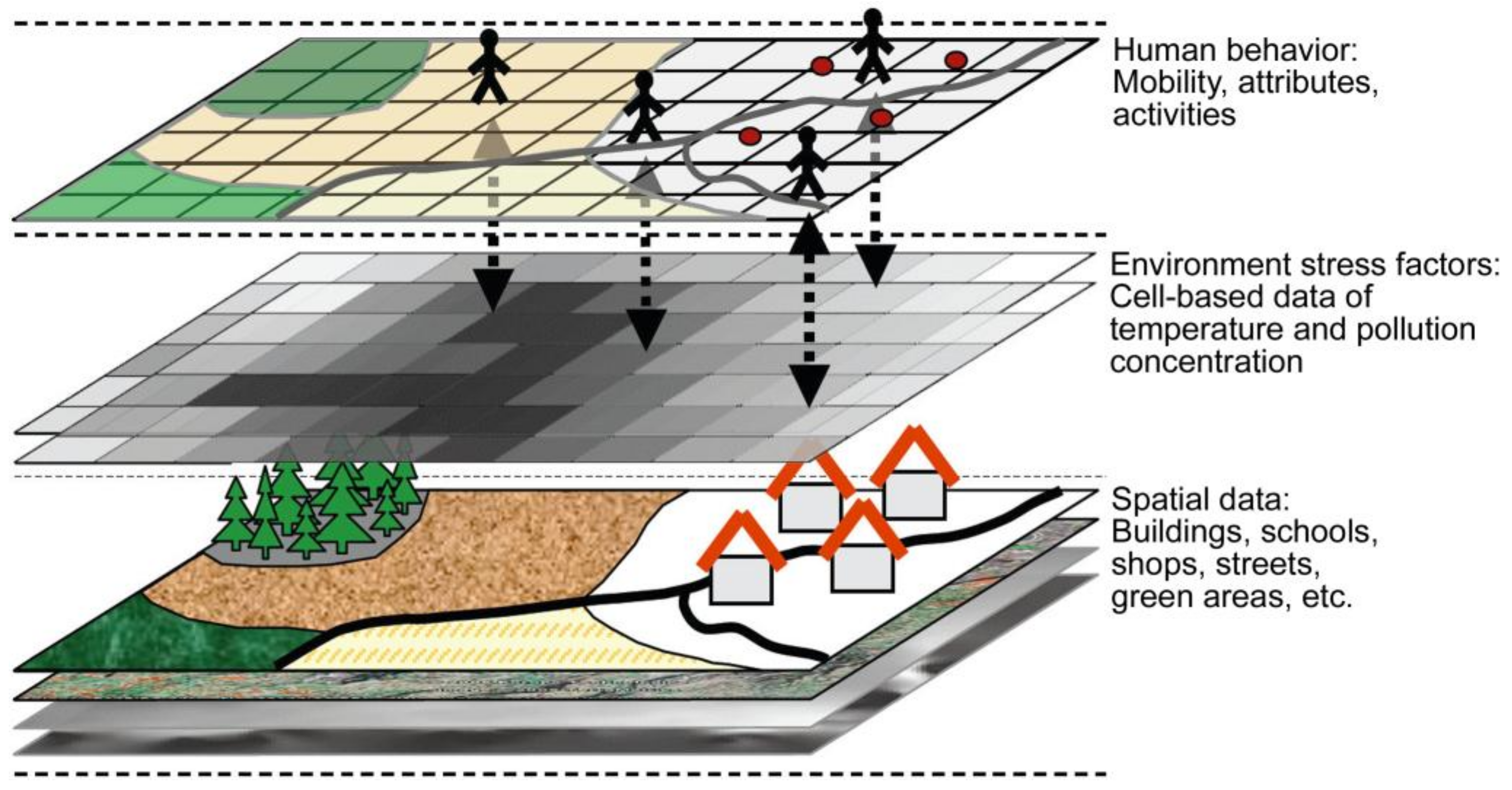
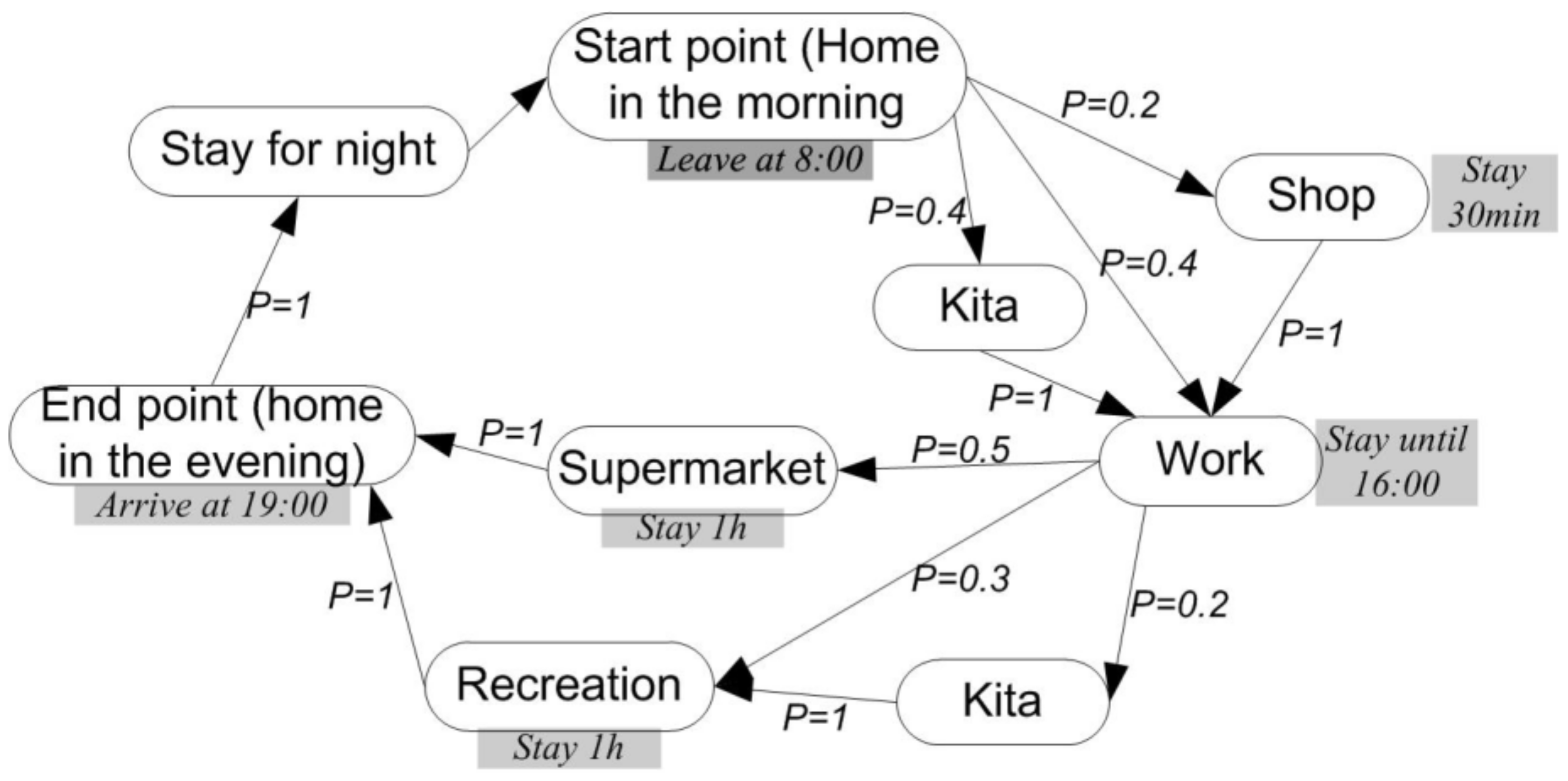
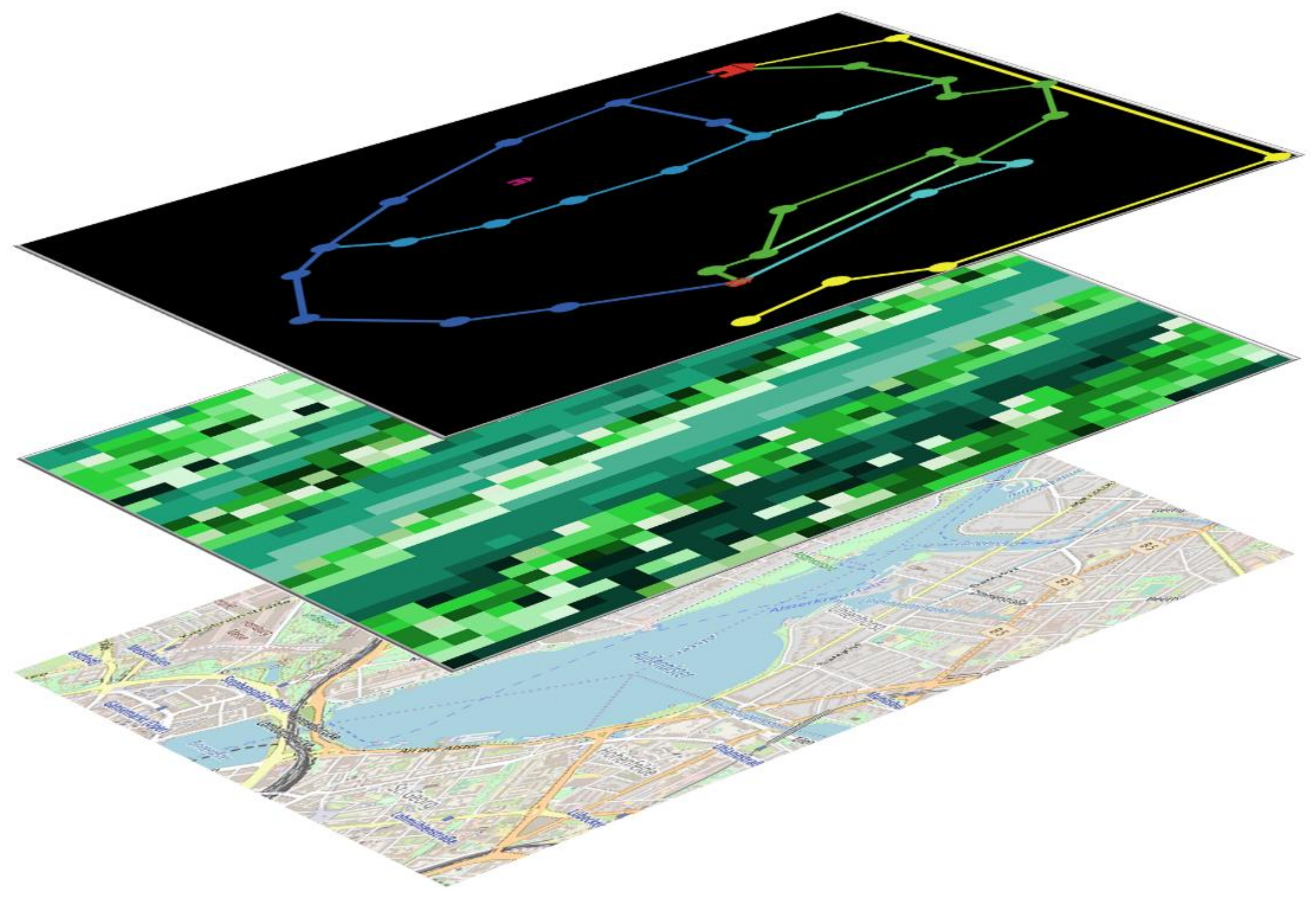
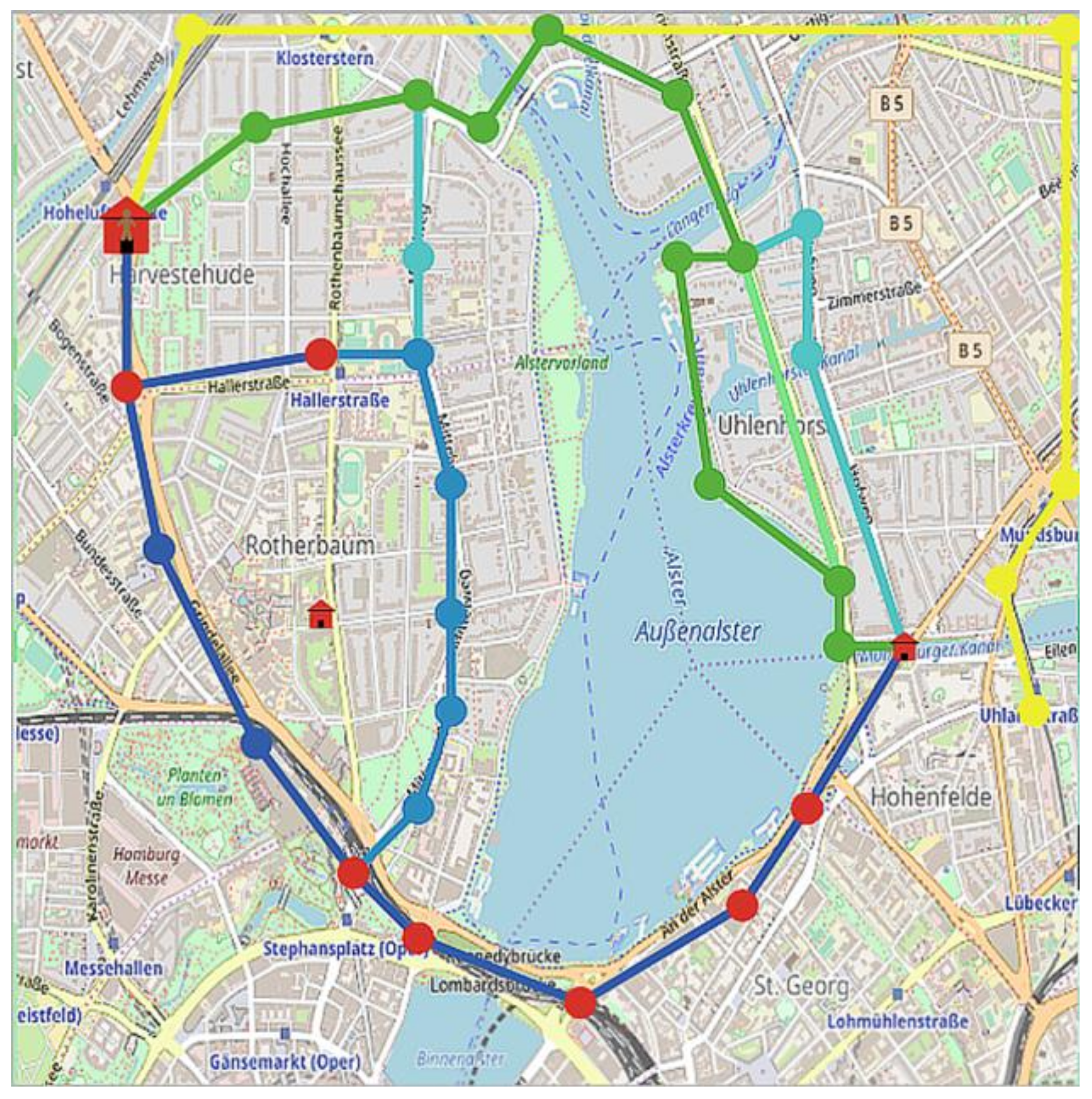
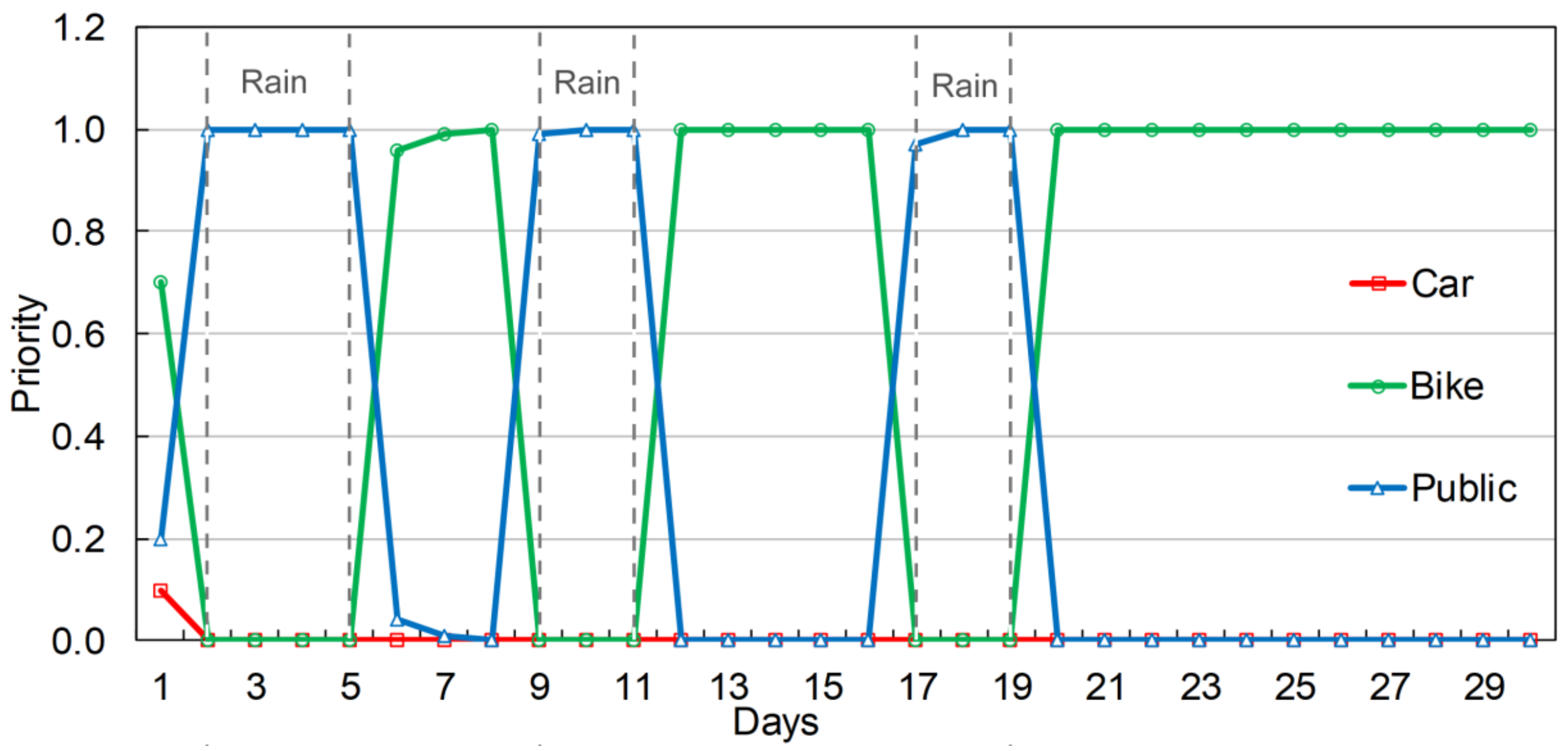
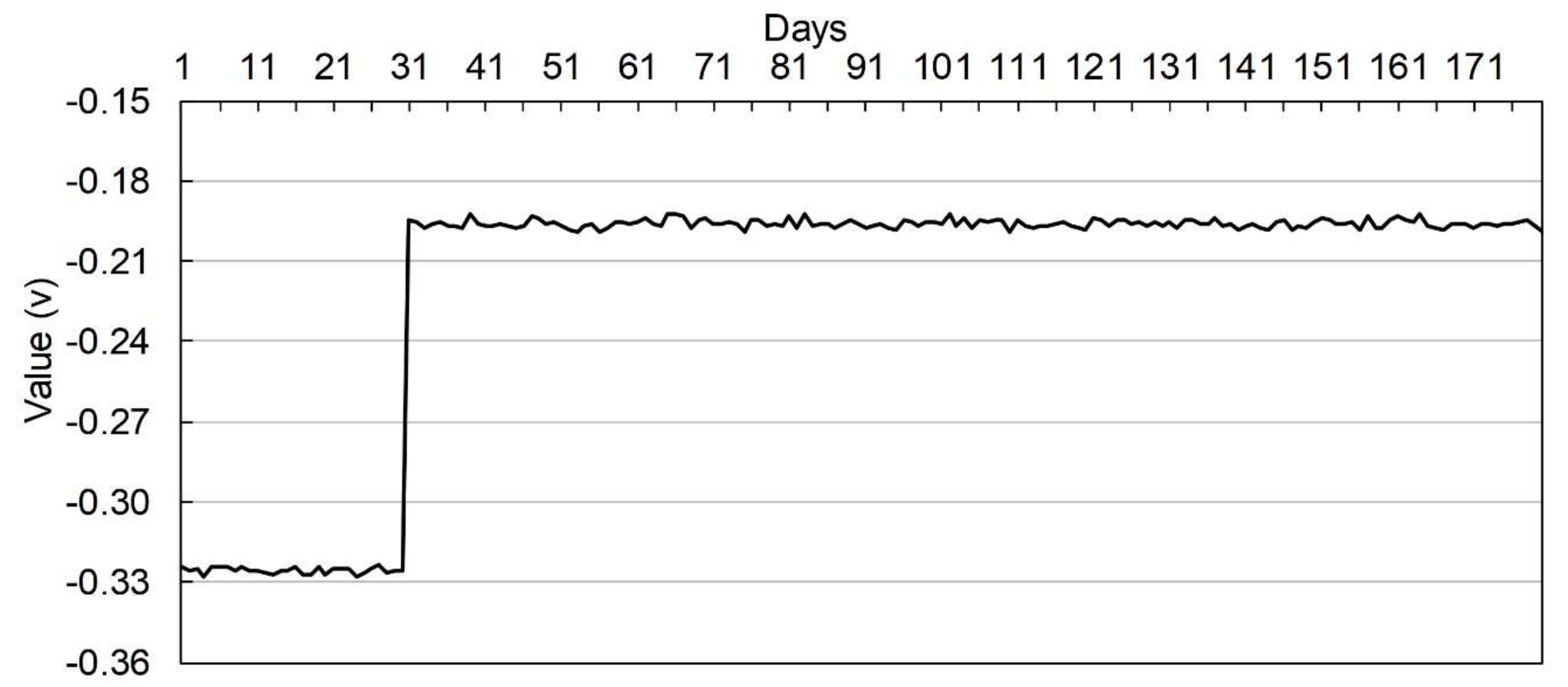
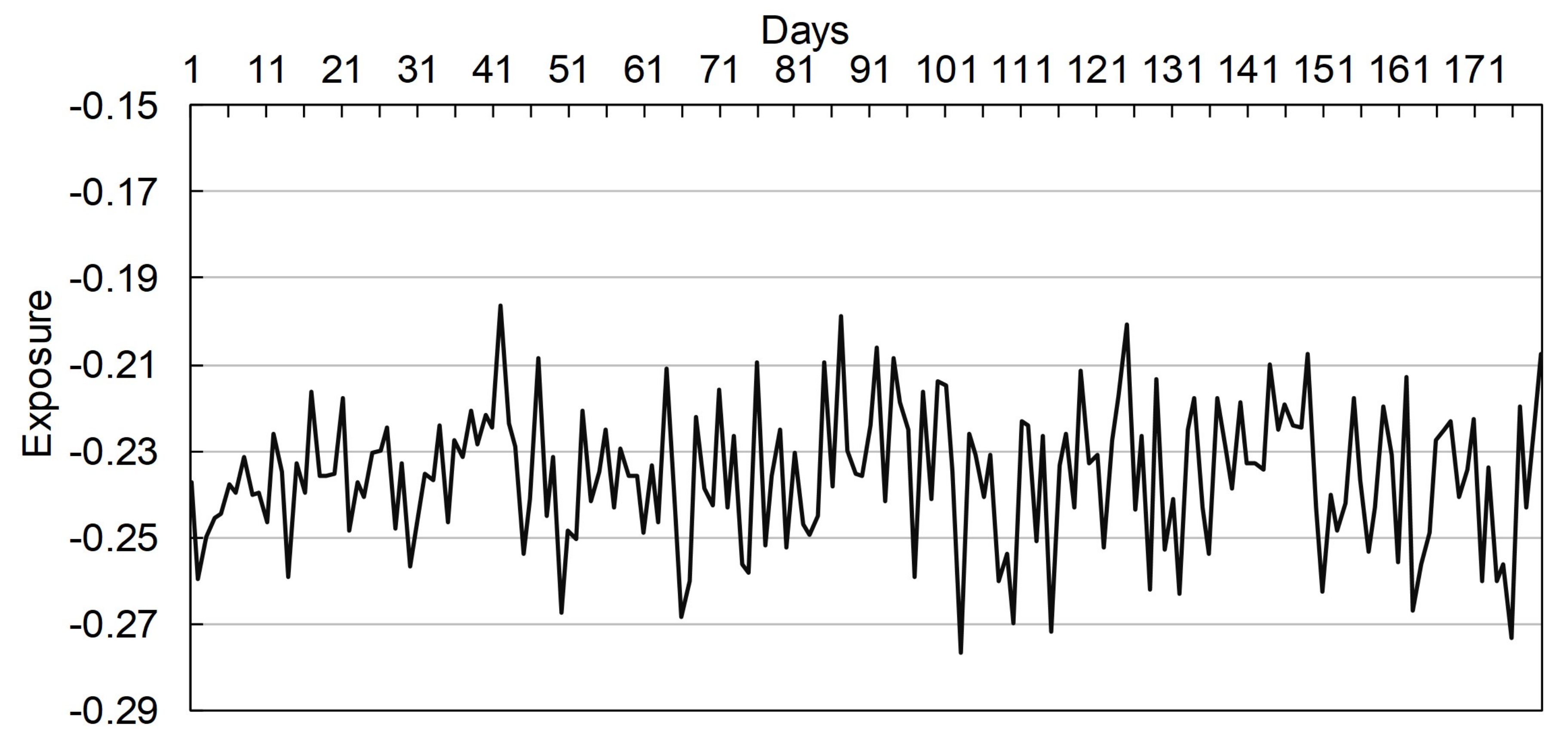
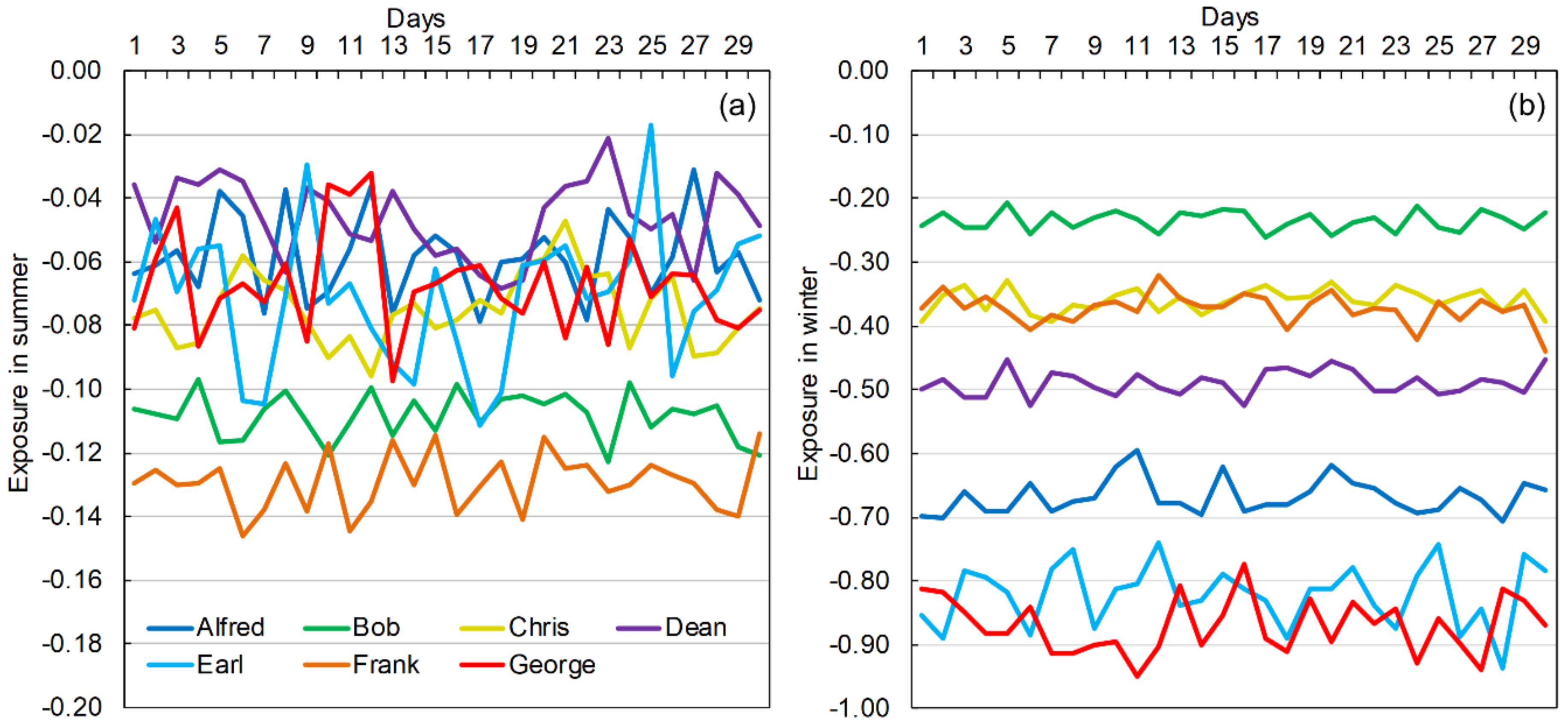
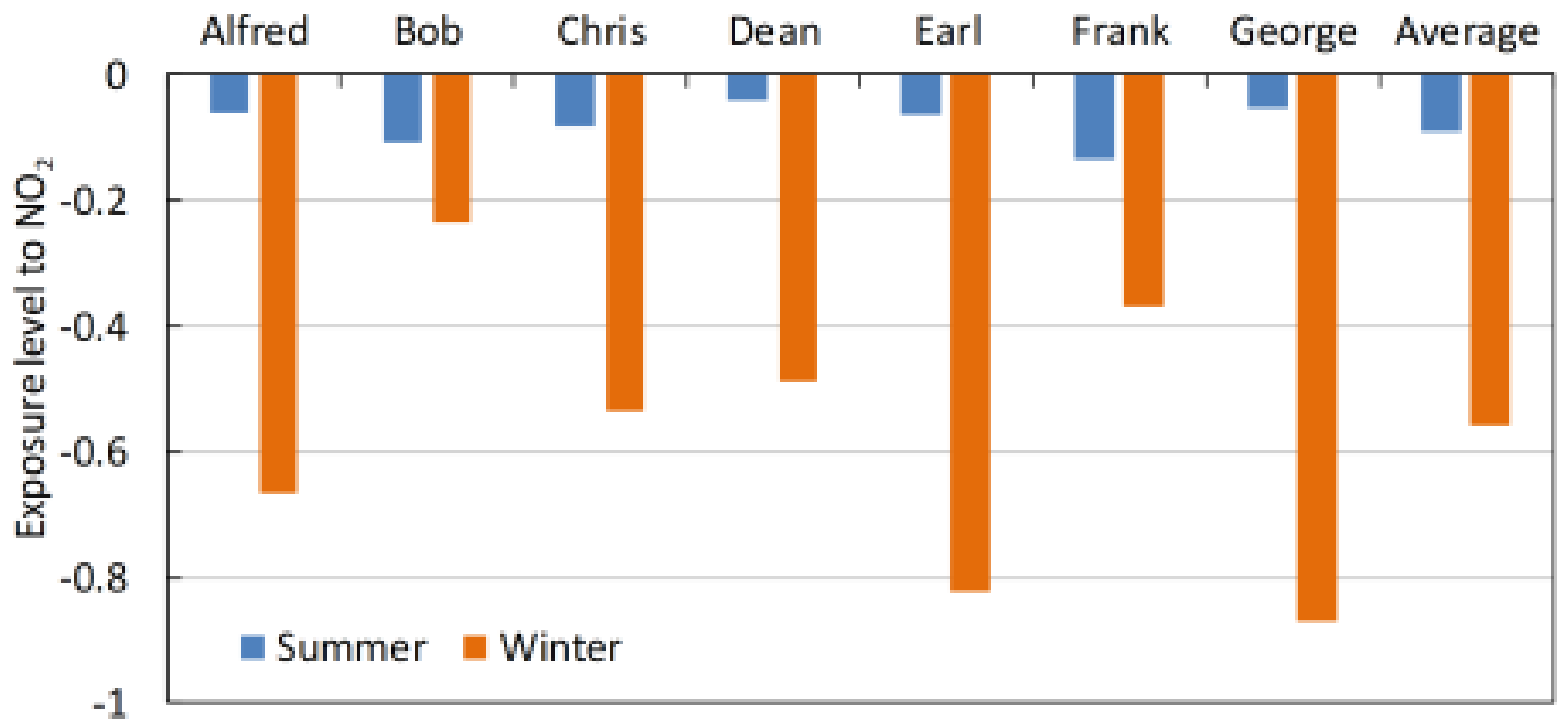
| Category | Model Principles | Example Models/Applications | Representative References | Model Features |
|---|---|---|---|---|
| Modeling of exposure sources | Estimation of the concentration, distribution, and transportation of exposure sources (pollutants, heat, humidity, radiation, etc.) | - Global air pollution (fine particles and ozone) assessment | Brauer et al. [26] | - Mainly physical aspects of exposure sources - Receptors ignored- Suitable in large scale and outdoor exposure - Result is a map (map set) of stressor concentrations |
| - Atmospheric Dispersion Modeling System (ADMS 5) | CERC, [30] | |||
| - Land-use regression (LUR) models | Beelen et al. [31] | |||
| - Multimedia exposure assessment modeling | CEAM, [29] | |||
| - Water quality regression model | Bain et al. [32] | |||
| - Indicator-based heat and air pollution combination | Willers et al. [20] | |||
| - Scenario projections from regional climate models | Jones et al. [33] | |||
| Modeling or assessment of exposed population | - Assess the population or area or property that is exposed to certain stressor concentrations - Compare the exposure status/level of sub-regions or sub-group of the population | - Modeling exposure to natural hazards such as flooding, cyclone, droughts | Jongman et al. [34]; Fuchs et al. [35] | - Offer an overview of group exposure - Produce relative comparison of sub-group’s exposures - Suitable in large scale and outdoor exposure - Result is a population or area associated with certain stressor concentration (population-weighted concentrations) |
| - Global and regional human exposures to air pollutions | Hystad et al. [36]; Wang et al. [37] | |||
| - Noise exposure model | Gulliver et al. [38] | |||
| - Traffic noise and pollution exposure model | Amirjamshidi et al. [39] | |||
| - Heat stress exposure model in combination with traffic model | Hoffmann et al. [40] | |||
| Modeling of individual’s exposure degree | - Assess the accumulation of exposure at a series of times and locations - Simulate the exposure degree of specific receptors - Mostly adopted with receptors’ mobility and activity | - Cumulative and Aggregate Risk Evaluation System (CARES) | ILSI, [41] | - Focus on sampled individual receptors - Suitable to model multiple stressors - Limited number of receptors - Specific and accurate at individual level - Result is an integrative degree/intensity of a subject being exposed (time-weighted concentrations) |
| - Lifeline (exposure to pesticide) | LifeLine, [42] | |||
| - Mobile-tracked traffic-related air pollution model | Liu et al. [43] | |||
| - Urban exposure in daily life routines | Schnell et al. [24] Schnell et al. [10] | |||
| - GPS-based modeling of urban exposure to air pollution | Dias and Tchepel, [7] | |||
| - Modeling exposure to multiple stressors | Dekoninck et al. [44] | |||
| - Personalized model of pesticide use | Leyk et al. [45] |
| Attributes | Behaviors | Agent groups |
|---|---|---|
| Age | Working | G1: worker, 18–30 years old, single, cycling, living in apartment older than 1980, shopping once a week |
| Gender | Shopping | |
| Employment | Child caring | G2: homemaker, 30–45 years old, married with children, using private car, living in suburban house, shopping daily |
| Living location | Entertaining | |
| Work location | Sleeping | G3: worker, 45–65 years old, children independent, using mixed transportations |
| Traffic type | Traveling | |
| Building type | Preventing | G4: retired couple, living in suburban house, using public transportation, shopping once a week |
| Regular runner | Running/jogging | |
| … | … | … |
| Car1 | Car2 | Car3 | Car4 | Car5 | Bike | Public | |
|---|---|---|---|---|---|---|---|
| Time [min] | 10 | 16 | 17 | 15 | 13 | 19 | 18 |
| Length [km] | 5.1 | 5.3 | 6.8 | 7.1 | 6.6 | 5.0 | 6.3 |
| Costs [€] | 1.53 | 1.59 | 2.04 | 2.13 | 1.98 | 0.4 | 1.07 |
| Agent Type | Alfred | Bob | Chris | Dean | Earl | Frank | George |
|---|---|---|---|---|---|---|---|
| Initial prioritycar | 0.1 | 0.95 | 0.65 | 0.333 | 0.1 | 0.333 | 0.8 |
| Initial prioritybike | 0.7 | 0.025 | 0.001 | 0.333 | 0.2 | 0.333 | 0.1 |
| Initial prioritypublic | 0.2 | 0.025 | 0.3499 | 0.333 | 0.7 | 0.333 | 0.1 |
| Adaptation rate (a) | 10 | 0.1 | 1.2 | 3 | 0.1 | 4 | 2 |
| Weighting factor for costs (α) | 0.6 | 0.05 | 0.3 | 0.1 | 0.45 | 0.8 | 0.8 |
| Weighting factor for time (β) | 0.1 | 0.75 | 0.1 | 0.7 | 0.45 | 0.1 | 0.1 |
| Weighting factor for exposure to environmental stressors (γ) | 0.3 | 0.2 | 0.6 | 0.2 | 0.1 | 0.1 | 0.1 |
| Desired temperature Tdesired [°C] | 23 | 18 | 21 | 23 | 23 | 19 | 28 |
© 2018 by the authors. Licensee MDPI, Basel, Switzerland. This article is an open access article distributed under the terms and conditions of the Creative Commons Attribution (CC BY) license (http://creativecommons.org/licenses/by/4.0/).
Share and Cite
Yang, L.E.; Hoffmann, P.; Scheffran, J.; Rühe, S.; Fischereit, J.; Gasser, I. An Agent-Based Modeling Framework for Simulating Human Exposure to Environmental Stresses in Urban Areas. Urban Sci. 2018, 2, 36. https://doi.org/10.3390/urbansci2020036
Yang LE, Hoffmann P, Scheffran J, Rühe S, Fischereit J, Gasser I. An Agent-Based Modeling Framework for Simulating Human Exposure to Environmental Stresses in Urban Areas. Urban Science. 2018; 2(2):36. https://doi.org/10.3390/urbansci2020036
Chicago/Turabian StyleYang, Liang Emlyn, Peter Hoffmann, Jürgen Scheffran, Sven Rühe, Jana Fischereit, and Ingenuin Gasser. 2018. "An Agent-Based Modeling Framework for Simulating Human Exposure to Environmental Stresses in Urban Areas" Urban Science 2, no. 2: 36. https://doi.org/10.3390/urbansci2020036
APA StyleYang, L. E., Hoffmann, P., Scheffran, J., Rühe, S., Fischereit, J., & Gasser, I. (2018). An Agent-Based Modeling Framework for Simulating Human Exposure to Environmental Stresses in Urban Areas. Urban Science, 2(2), 36. https://doi.org/10.3390/urbansci2020036







